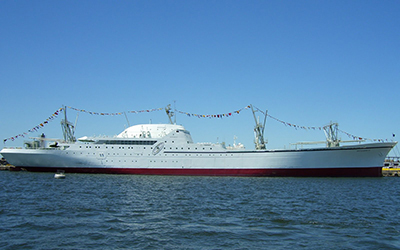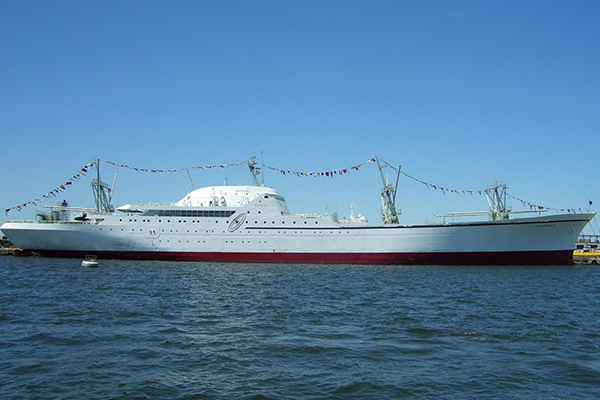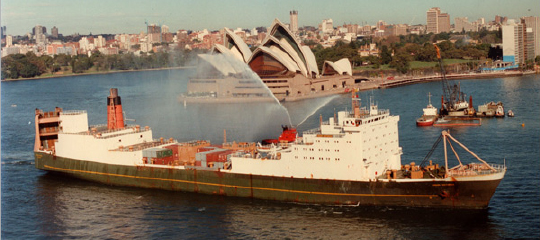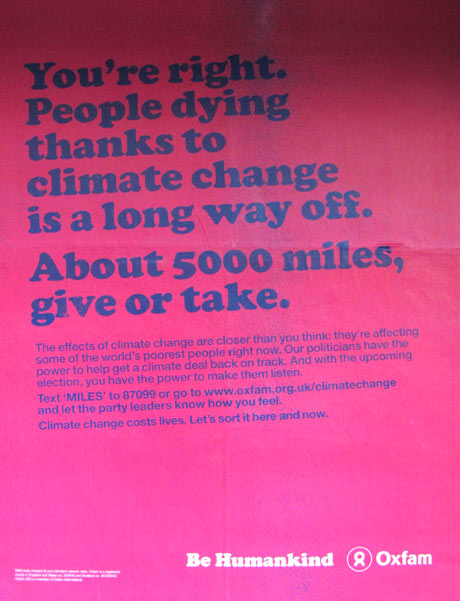Future of Aotearoa is nuclear visits

Footnote added 2 November 2010

Beautiful and Clean: The nuclear ship Savannah was seen as toxic, by a world blind to the damage routinely being done by fossil-fueled shipping. image Atomic Insights
Blanket-banned for nearly all the right reasons.
In 1984, when nuclear-powered ships were banned from visiting Aotearoa, the French military was to continue testing nuclear weapons beneath Moruroa and Fangatafoa for more than 11 years. And the following year French intelligence mined the Rainbow Warrior while she was berthed in Auckland, killing Greenpeace photographer Fernando Pereira.
So, if Aotearoa was to embrace nuclear shipping now, it would be certain to raise international eyebrows.
In the 1980s, the greatest perceived threat to the planet was still nuclear war, as it had been since the 1950s. But by the late 1980s, atmospheric scientists were testifying to a threat arising not from warlike aspirations, but from the peaceful use of fossil fuel.
Nuclear winter was universally seen by the world as an unacceptable risk; an affront to sanity. Aside from the likes of the mentally impaired Ronald Regan, all major leaders from Kennedy and Khrushchev onward have striven to step back from the nuclear abyss. In contrast, the annihilation threatened by anthropogenic global warming strongly motivates only heads of miniscule states such as the Republic of Kiribati.
New Zealanders are justifiably proud of their nuclear free zone legislation, and grateful for Aotearoa’s isolation from an increasingly overcrowded world. But that virtue of isolation is rapidly becoming a curse, thanks to the tyranny of distance and an utter dependency on fossil-fueled transportation. Ecotourism, in the antipodes, is an increasingly obvious oxymoron. And flying food to the Northern Hemisphere borders on obscene, in the face of deaths directly attributable to global warming. Last year the World Health Organisation reported:

Not Beautiful but Relatively Clean: Unlike the bulk of the world’s shipping, which runs on bunker fuel, the ‘gas’ turbine of the Union Rotorua burnt relatively clean light marine diesel. image Marine Photography Epping
Climate change was estimated to be already responsible for 3% of diarrhoea, 3% of malaria and 3.8% of dengue fever deaths worldwide in 2004. Total attributable mortality was about 0.2% of deaths in 2004; of these, 85% were child deaths. In addition, increased temperatures hastened as many as 12 000 additional deaths; however these deaths were not included in the totals because the years of life lost by these individuals were uncertain, and possibly brief.
While Aotearoa is spoilt for choice regarding options for phasing out fossil fuels for road transport and electricity generation, shipping, including the Cook Strait ferries, poses an altogether more intractable problem. Marine transport possibly represents 3% of all anthropogenic sources of greenhouse gases—heading for 1.7 billion tonnes of carbon dioxide annually, in 2050.
A raft of measures is being considered to reduce shipping emissions. The most immediately available response is to simply slow down. The obvious impediment is that goods are delivered more slowly, meaning some will be flown instead—at far greater cost to the atmosphere. But the reason ships have always sought speed is not simply to reach a market first—as immortalised by the tea clipper Cutty Sark. The cardinal need for speed is to deliver more cargoes over the working life of a ship.
The imperative to deliver cargo after cargo in relentless manner is why steam supplanted sail so decisively. Sail has an attractive future but as a niche rather than blanket replacement of oil-powered shipping. One of the desperate measures being contemplated for reducing emissions is requiring docked ships to plug in to shore power. This can have the additional advantage of a ship being able to help out a city, as happened in Auckland in 1998 when the Union Rotorua provided 20 megawatts of electricity after the transmission lines feeding the central business district failed. Nuclear-powered ships could potentially routinely plug in and supply power to the ports working ’em.

Reasonably Restrained: Britain’s advertising standards authority has rejected complaints against Oxfam’s, quoting the World Health Organisation and others, and noting that its posters were ‘reasonably restrained’. image The Guardian
Similarly, gains are being made in aviation at the airport—a large number are now installing fixed electrical ground power units, to allow the aircraft’s auxiliary power generators to be turned off. And by utilising tugs, rather than taxiing aircraft with their main engines—an obscenely noisy and inefficient practice—emissions are being vastly reduced. The low-tech expedient of shutting down the duty-free racket would possibly contribute as much—filling overhead lockers with bottles of spirits is a quaint but costly custom that should be immediately consigned to the annals of things that were silly that when first practiced, but are now silly and indecent.
For Aotearoa to have a long-term future as a tourist destination depends on there being an alternative to flying. Aviation is already highly optimised, and while it will become more so with the likes of blended wing–body airframes, it is an inherently inefficient form of transportation, on account of the percentage of fuel burned simply to keep vessel and cargo aloft.
When high-speed ocean liners—30 knots plus, as compared to cruise ships at closer to 20—stage the comeback that is inevitable when restrictions on aviation bite, nuclear power offers the greatest opportunity to curtail carbon dioxide production. For Aotearoa to have a plausible position on reducing tourism-related greenhouse gas emissions, it cannot arbitrarily reject nuclear ships.
Cook Strait could boast the prettiest, fastest and most sea-kindly ferries afloat. And Aotearoa could welcome the most beautiful liners yet-to-be-built.
But by all means ban the nuclear-armed, for eternity.
The Union Rotorua
In one of his former lives, long-serving Mahurangi Regatta shoreside director Michael Gordon was the chief engineer of the Union Rotorua, one of the Union Company’s roll-on, roll-off trans-Tasman ships. The Union Rotorua and sister ship Union Rotoiti were unusual, being powered by marine gas turbines, which generated the power to drive electric motors that turned the propeller shafts. When the oil shocks of the 1970s made the gas turbines conspicuously expensive—at least to the short-sighted eyes of Union Company accountants—to run, chief engineer Gordon ‘drew the short straw’ to supervise the replacement of the Union Rotoiti’s gas turbine with three Wartsila diesels. Fortunately for power-crippled Auckland in 1998, the Union Rotorua was available to provide crucial current to shore—her final act of service.
She was scrapped the following year, on the forlorn shoreline of Bangladesh.
